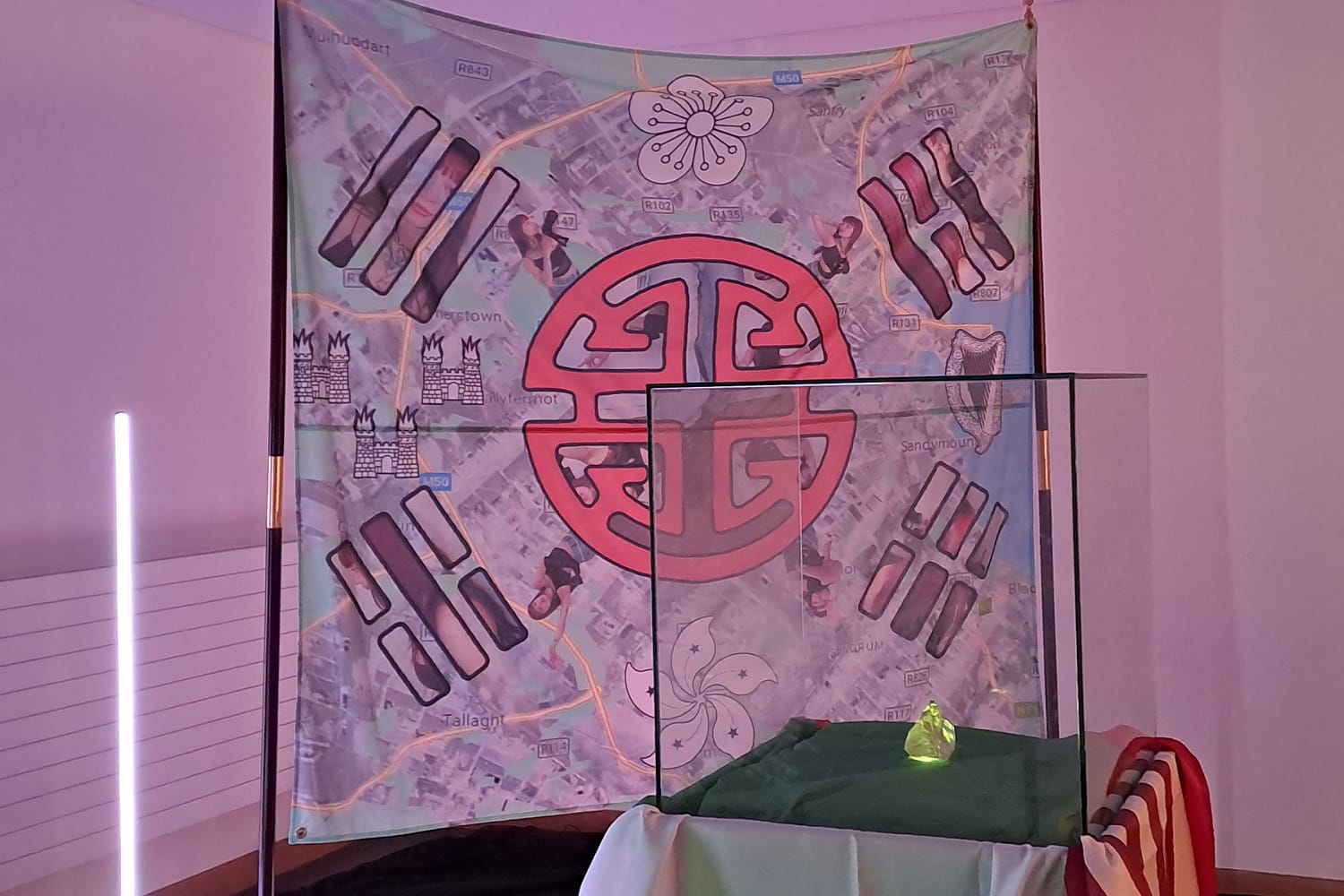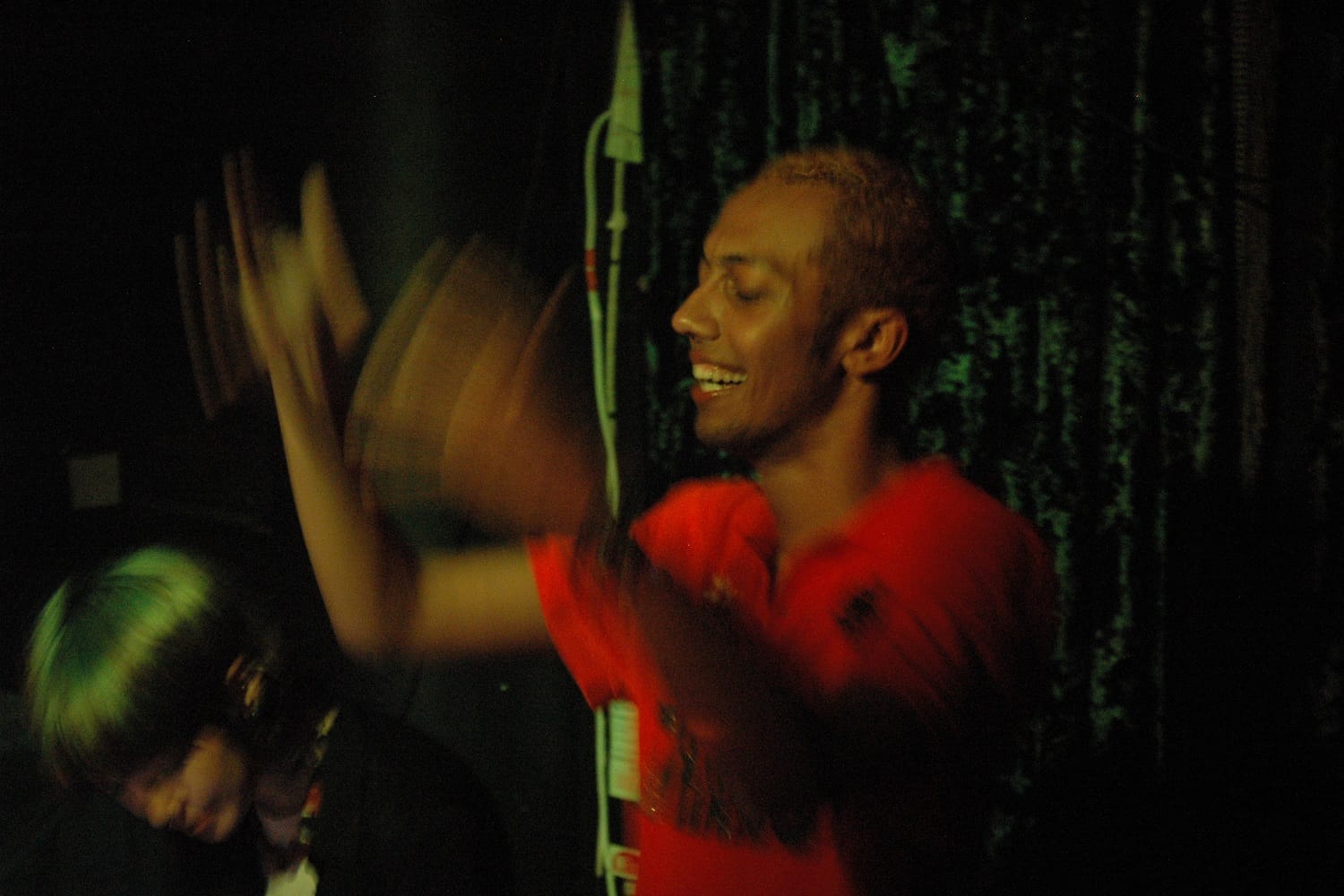What’s the best way to tell area residents about plans for a new asylum shelter nearby?
The government should tell communities directly about plans for new asylum shelters, some activists and politicians say.
Daranijoh Sanni’s work “Refractions” is part of the PhotoIreland Festival 2023, now on at The Printworks at Dublin Castle.

A babel of recorded voices echo through the reception of The Printworks at Dublin Castle.
The voices spread from three sets of speakers, sat in a shadowy corner of the long room facing onto the courtyard.
The chatter lies over a ghostly high-pitched hum, like the sound of a finger running along the rim of a wine glass.
Most of the reception was lit by the sun through its windows last Thursday. But this small bit of the room was illuminated by fluorescent lights.
Green, red and blue glowing tubes were positioned around a triptych of flags, each of which featured a collage made from maps, symbols, objects and photos of the people whose voices created the chatterscape.
One flag recreates the Stars and Stripes using a single male body.
Another decorates a map of Dublin city with images of Irish-Cantonese dancer Aiesha Wong and references details taken from the Hong Kong, Taiwanese and South Korean flags.
Titled “Refraction”, the work was created by Daranijoh Sanni, a visual and sound artist who operates under the moniker of E the Artist.
Each flag, Sanni says, is his depiction of an interview with his subjects, interrogating how they immerse themselves within contemporary Irish culture, and how they are perceived.
“These flags aren’t actually flags for anything except for my personal interpretations of them,” he says.
The idea behind the flags becomes almost paradoxical, as they represent his own understanding of a single person but could also be treated as a commentary on a whole community, he says.
“I like this idea of story-telling, and very anecdotal views of cultures that we have where people form prejudices,” says Sanni.
“Refraction” is being shown from 30 June to 27 August as part of the annual PhotoIreland Festival, this year titled “R/evolutions”.
The evening before it was due to launch on Friday, Sanni was adding the finishing touches to the installation.
A cleaner hoovers the reception. Sanni lowers a large glass case over a long rectangular pedestal positioned in the centre of the space, between the three flags he designed.
Four more flags are draped over the stand, these belonging to Nigeria, China, the United States and Ireland.
Resting on the top of this is a small, curved glass object with an uneven surface. Beneath it is a small green light.
As the green light travels through the dense sculpture, it refracts, obscuring its source, Sanni says. “You could stand it one hundred different places, but you’ll never actually see what makes the object itself come alive.”

The light as it is refracted, Sanni says, is comparable to the constantly evolving interpretations of what a flag or national symbol represents. “These exist like a medium in which a group of people come about.”
“Refraction”, he says, is intended to question the purpose of national flags and reflect on the meaning behind a cultural symbol – like a crest of arms – when it is placed within a setting that doesn’t recognise or welcome it.
His go-to example is the most autobiographical of the three flags. Titled “Kobo”, it interprets the story of his father, a self-employed taxi driver.
The flag recreates the Nigerian state of Lagos’ crest through cut-up photos of a Dublin taxi. Sanni’s version replaces the original wheel with a rubber tyre, its six cowry shells with coins, and the image of two men fishing with a car engine.
Floating over a monochrome view of Lagos city, a pair of car doors extend from the crest like wings.
“It borders this idea of the line between man and machine,” Sanni says.
People who immigrate to Ireland are under immense pressure to start earning right away, he says. “You have to make a certain amount of money in your first year, which is why people will work and then do Deliveroo, doing all the jobs Irish people don’t want to do.”
Born in Coolock, 21-year-old Sanni’s first major venture was as co-founder of the clothing brand Korpse in June 2020.
The following year, he branched out into music production, remixing tracks for the digital hardcore artist Julia Louise Knifefist, and rapping on tracks for producer Rory Sweeney.
Says Sweeney: “He’s really tall and because of that, he’s got this really, really deep voice, and when he leans into it. It’s just attention grabbing.”
In August 2022, he helped to co-found Stray Magazine, an online publication which documented Dublin’s subcultures and peripheral artists.
That same month, he launched Fight Night, an ongoing club night styled on old-school fighter video games like Tekken – and which, he says, gradually evolved into an event that brought DJs from minority communities into more established venues.
Sanni became involved in the PhotoIreland festival through the Irish-Sierra Leonean visual artist Alice Rekab.
Says Rekab: “I was receiving invitations into high-profile spaces, and I wanted to make that meaningful by creating a space for representations of the nuance and multiplicity of the mixed and black Irish experience.”
His social-media profile caught their attention during the pandemic, when live music events were on hold, they say.
“His energy was right, and I just thought ‘Shit, this is great’, and as we were coming back out into the world, it was a case of me wanting to join them,” says Rekab.
After their solo exhibition, Family Lines, which looked looked at their mixed-race identity and family history and ran in the Douglas Hyde Gallery between July and September 2022, the pair collaborated on a project titled BlackBoysBlush*.
The project, a three-part series, comprised a visual book of interviews with artists of colour, a compilation album which spliced several of the conversations with electronic music, and a live event in the gallery.
“Our collaboration was always easy,” Rekab says. “Because we want the same thing in our work and share the same values.”
At 1am on Saturday morning, hours after the “Refraction” installation had been launched in Dublin Castle, Sanni took to the stage in the Grand Social to close the night out with a DJ set.
An exhausted doorman waved people into the downstairs performance venue, indifferent to his list. Guys entered in shirts decorated with luminous green high-vis strips and paddy caps made out of tin foil.

Onstage, Sanni was joined by the DJ, writer and co-founder of Stray, Ly Hagan.
Bouncing frantically, the duo flitted between spinning cheesy Eurodance and feral experimental hip-hop tracks.
Above anything else, Sanni says, collaboration is what he values in his creative process, whatever form that may take. “Everything exists in its best form when it’s a conversation.”
“I might say something and a person reacts, and there becomes, as bell hooks says, this ‘pool of meaning’,” he says. “We look into it and find beautiful colours and statements, but what lies in the very middle is what always connects us.”
Get our latest headlines in one of them, and recommendations for things to do in Dublin in the other.